《儿科学》课程教学资源(授课教案)10 Nutritional Iron Deficiency Anemia
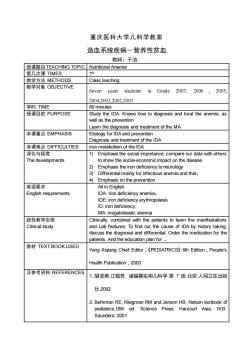
重庆医科大学儿科学教案造血系统疾病一营养性贫血教师:于洁授课题目TEACHING TOPIC Nutritional Anemia第几次课TIMES7th教学方法METHODSClass teaching教学对象OBJECTIVESevenstudents2005,yearsGrade200720062004.2003.2002.2001学时:TIME80 minutes授课目的PURPOSEStudythe IDA.Knows how to diagnosis and treat the anemia,aswell as the preventionLearn the diagnosis and treatment of the MA本课重点EMPHASISEtiology forIDAand preventionDiagnosis and treatment of the IDA本课难点 DIFFICULTIESIron metabolism of the IDA深化与拓宽Emphasis the social importance; compare our data with othersThe developmentstoshowthesocial-economicimpactonthedisease2Emphasis the iron deficiency to neurology3)Differential mainly for infectious anemia and thal;4) Emphasis on the prevention英语要求All inEnglishIDA: ron deficiency anemia;English requirementsIDE:iron deficiency erythropoiesisID: iron deficiency;MA: megaloblastic anemia践性教学安排Clinically, combined with the patients to learn the manifestationsClinical studyand Lab features; To find out the cause of IDA by history taking;discuss the diagnossi and differential. Order the medication for thepatients.Andtheeducation planfor教材TEXTBOOKUSEDYang Xiqiang Chief Editor,《PEDIATRICS》 6th Edion, People'sHealth Publication,2003及参考资料REFERENCES1.胡亚美,江载芳.诸福棠实用儿科学.第7版.北京:人民卫生出版社,20022. Behrman RE, Kliegman RM and Jenson HB. Nelson textbook opediatrics.16th ed. Science Press, Harcourt Asia, W.B.Saunders, 2001
重庆医科大学儿科学教案 造血系统疾病-营养性贫血 教师:于洁 授课题目TEACHING TOPIC Nutritional Anemia 第几次课 TIMES 7 th 教学方法 METHODS Class teaching 教学对象 OBJECTIVE Seven years students in Grade 2007, 2006 , 2005, 2004,2003,2002,2001 学时: TIME 80 minutes 授课目的 PURPOSE Study the IDA. Knows how to diagnosis and treat the anemia, as well as the prevention Learn the diagnosis and treatment of the MA 本课重点 EMPHASIS Etiology for IDA and prevention Diagnosis and treatment of the IDA 本课难点 DIFFICULTIES Iron metabolism of the IDA 深化与拓宽 The developments 1) Emphasis the social importance; compare our data with others to show the social-economic impact on the disease 2) Emphasis the iron deficiency to neurology 3) Differential mainly for infectious anemia and thal; 4) Emphasis on the prevention 英语要求 English requirements All in English IDA: Iron deficiency anemia; IDE: iron deficiency erythropoiesis ID: iron deficiency; MA: megaloblastic anemia 践性教学安排 Clinical study Clinically, combined with the patients to learn the manifestations and Lab features; To find out the cause of IDA by history taking; discuss the diagnossi and differential. Order the medication for the patients. And the education plan for 。 教材 TEXT BOOK USED Yang Xiqiang Chief Editor,《PEDIATRICS》6th Edition,People’s Health Publication,2003 及参考资料 REFERENCES 1. 胡亚美,江载芳. 诸福棠实用儿科学.第 7 版.北京:人民卫生出版 社,2002 2. Behrman RE, Kliegman RM and Jenson HB. Nelson textbook of pediatrics.16th ed. Science Press, Harcourt Asia, W.B. Saunders, 2001
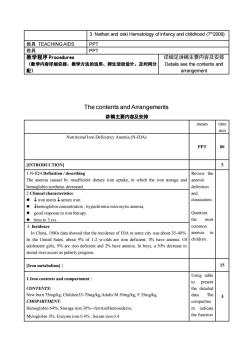
3. Nathan and oski Hematology of infancy and childhood (7ih2009)教具TEACHINGAIDSPPT教具PPT教学程序Procedures详细见讲稿主要内容及安排(教学内容详细安排、教学方法的运用、师生活动设计、及时间分Details seethecontents and配)arrangement The contents and Arrangements讲稿主要内容及安排meanstimeminNutritional Iron Deficiency Anemia (N-IDA)PPT80INTRODUCTION)51.N-IDA Definition /describingReviewtheThe anemia caused by insufficient dietary iron uptake,in which the iron storage andaneminhemoglobin synthesis decreaseddefinition2.Clinical characteristicsandclassication.+iron stores+serum iron.hmintanhmmoyicaQuestion:good response toirontherapy6mo to 3 yrsthemost3. IncidencecommonIn China,1980s data showed that the incidence ofIDAin some city was about 35-40%anemiainInthe United Saesabout 9%f2yldsareiron deficien3%haveanmachildreadolescent girls, 9% are iron deficient and 2% have anemia. In boys, a 50% decrease instored iron occurs as puberty progress15[ron metabolism] :Using table1.Iron contents and compartment :topresentCONTENTS:the detailedNew born 75mg/kg: Children35-70mg/kg,Adults M 50mg/kg,F 35mg/kgThedata.3CMOPARTMENT:compartmeHemoglobin 64%, Storage iron 30%--ferritin/Hemosiderinnt indicatethe functionMyloglobin 3%;Enzyme iron 0.4%; Serum iron 0.4
3. Nathan and oski Hematology of infancy and childhood (7th2009) 教具 TEACHING AIDS PPT 教具 PPT 教学程序 Procedures (教学内容详细安排、教学方法的运用、师生活动设计、及时间分 配) 详细见讲稿主要内容及安排 Details see the contents and arrangement The contents and Arrangements 讲稿主要内容及安排 means time min Nutritional Iron Deficiency Anemia (N-IDA) PPT 80 [INTRODUCTION] 5 1.N-IDA Definition / describing The anemia caused by insufficient dietary iron uptake, in which the iron storage and hemoglobin synthesis decreased. Review the anemin definition and classication. Question: the most common anemia in children. 2.Clinical characteristics ⚫ iron stores serum iron ⚫ hemoglobin concentration , hypochromic microcytic anemia, ⚫ good response to iron therapy. ⚫ 6mo to 3 yrs. 3. Incidence In China, 1980s data showed that the incidence of IDA in some city was about 35-40%. In the United Sates, about 9% of 1-2 yr-olds are iron deficient; 3% have anemia. Of adolescent girls, 9% are iron deficient and 2% have anemia. In boys, a 50% decrease in stored iron occurs as puberty progress. [Iron metabolism]: 15 1.Iron contents and compartment: CONTENTS: New born 75mg/kg; Children35-70mg/kg;Adults M 50mg/kg, F 35mg/kg. CMOPARTMENT: Hemoglobin 64%; Storage iron 30%-ferritin/Hemosiderin; Myloglobin 3%; Enzyme iron 0.4% ; Serum iron 0.4 Using table to present the detailed data. The compartme nt indicate the function 3
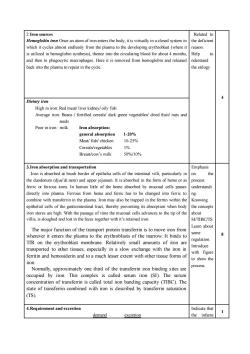
2.Iron sourRelated toHemoglobin ironthe deficienttuallyinaoseowhich itcycles almost endlesslyfrom the plasma to the developing erythroblast (whereitreasonis utilized in hemoglobin synthesis), thence into the circulating blood for about 4 monthsHelptoand then to phagocytic macrophages. Here it is removed from hemoglobin and releasednderstandackintepeat in the cyclthe etilogyDietary ironHigh in iron: Red meat/ liver kidney/ oily fishAverage iron: Beans / fortified cereals/ dark geen vegetablesl dried fuit/ nuts andeedsPoor in iron: milkIron absorption1-20%general absorption10-25%Meat/ fish/ chicken1% Cereals/vegetables50%/10%Breast/cow's milk3.Iron absorpEmphasison and transportatiorIron is absorbed at brush border of epithelia cells of the intestinal villi, particularly inonthethe duodenum (djue'dinem) and upper jejunum. It is absorbed in the form of heme or asprocesferric or ferrous irons.In human little of theheme absorbed by mucosal cells passe:understandidirectlyfromknd ferric has to be changed into ferrintKnowingcombinethe plasma. Iron may also be trapped in the ferrtiwithintheepithelial cells of the gastrointestinal tract, thereby preventing its absorption when bodythe conceptsiron stores are high With the passage of time the mucosal cells advances to the tip of the aboutSI/TIBC/TSvillis, is sloughed and lost in the feces together with it's retained iron.Learn abouthectionoftlerrin is to move iron fronsport protein transfeSOwherever it enters the plasma to the erythroblasts of the marrow. It binds toregulation.TfR on the erythroblast membrane. Relatively small amounts of iron areIntroducetransported to other tissues, especially in a slow exchange with the iron inwith figureferitin and hemosiderin and to a much lesser extent with other tissue forms ofto show theirorprocessoximately one third of the transferrin iron binding sites areorly.approoccupied by iron. This complex is clled serum iron (SI)Theserumconcentration of transferrin is called total iron banding capacity (TIBC). Thestate of transferin combined with iron is described by transferin saturation(TS).4.Requirement and excretionIndicate that 1demandthe infantsexcretion
2.Iron sources Hemoglobin iron Once an atom of iron enters the body, it is virtually in a closed system in which it cycles almost endlessly from the plasma to the developing erythroblast (where it is utilized in hemoglobin synthesis), thence into the circulating blood for about 4 months, and then to phagocytic macrophages. Here it is removed from hemoglobin and released back into the plasma to repeat in the cycle. Related to the deficient reason. Help to nderstand the etilogy 4 Dietary iron High in iron: Red meat/ liver kidney/ oily fish Average iron: Beans / fortified cereals/ dark green vegetables/ dried fruit/ nuts and seeds Poor in iron : milk Iron absorption: general absorption 1-20% Meat/ fish/ chicken 10-25% Cereals/vegetables 1% Breast/cow’s milk 50%/10% 3.Iron absorption and transportation Iron is absorbed at brush border of epithelia cells of the intestinal villi, particularly in the duodenum (djue’di:nem) and upper jejunum. It is absorbed in the form of heme or as ferric or ferrous irons. In human little of the heme absorbed by mucosal cells passes directly into plasma. Ferrous from heme and ferric has to be changed into ferric to combine with transferrin in the plasma. Iron may also be trapped in the ferrtin within the epithelial cells of the gastrointestinal tract, thereby preventing its absorption when body iron stores are high. With the passage of time the mucosal cells advances to the tip of the villis, is sloughed and lost in the feces together with it’s retained iron. The major function of the transport protein transferrin is to move iron from wherever it enters the plasma to the erythroblasts of the marrow. It binds to TfR on the erythroblast membrane. Relatively small amounts of iron are transported to other tissues, especially in a slow exchange with the iron in ferritin and hemosiderin and to a much lesser extent with other tissue forms of iron. Normally, approximately one third of the transferrin iron binding sites are occupied by iron. This complex is called serum iron (SI). The serum concentration of transferrin is called total iron banding capacity (TIBC). The state of transferrin combined with iron is described by transferrin saturation (TS). Emphasis on the process understandi ng. Knowing the concepts about SI/TIBC/TS Learn about some regulation. Introduce with figure to show the process. 8 4.Requirement and excretion demand excretion Indicate that the infants 1
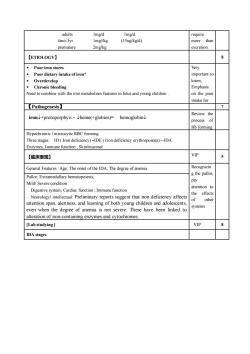
1mg/d1mg/drequiredults 4mo-3yr1mg/kg(15ug/kg/d)morethanpremature2mg/kgexcretion.[ETIOLOGY]8Pooriron storeVeryPoor dietary intake of ironimportant toOverdevelopknow,Chronic bleedingEmphasisNeed tocombinewiththeironmetabolismfeatures infetus and youngchildrenon the poorintake for【Pathogenesis]Reviewtheirond+protoporphyri-heme(+globins)=hemoglobinprocessofHbformingHypochromic /microcytic RBC formingThree stages:ID (Iron deficiency)-IDE (Iron deficiency erythropoiesis) --IDAEnzymes,Immunefunction;Skin/mucosalvIP【临床表现】5RecognizinGeneralFaturesgTheonsetofthAhdegeefanmag the pallor,Pallor; Extramedullary hematopoiesispayMild/Severe conditionattention toDigestivesystemCardiacfunctionImmunefunctionthe effectsNeurology/ intellectual: Preliminary reports suggest that iron deficiency affectsofotherattention span, alertness, and learning of both young children and adolescents,systemseven when the degree of anemia is not severe. These have been linked toalteration of iron-containing enzymes and cytochromes[Lab studying ]VIPSIDA stages
adults 1mg/d 1mg/d 4mo-3yr 1mg//kg (15ug/kg/d) premature 2mg/kg require more than excretion. 【ETIOLOGY】 8 • Poor iron stores • Poor dietary intake of iron* • Overdevelop • Chronic bleeding Need to combine with the iron metabolism features in fetus and young children . Very important to know; Emphasis on the poor intake for 【Pathogenesis】 7 iron+protoporphyri-heme(+globins)= hemoglobin Review the process of Hb forming Hypochromic / microcytic RBC forming Three stages: ID ( Iron deficiency) –IDE ( Iron deficiency erythropoiesis) -IDA. Enzymes; Immune function ; Skin/mucosal 【临床表现】 VIP 5 General Features : Age; The onset of the IDA; The degree of anemia Recognizin g the pallor, pay attention to the effects of other systems Pallor; Extramedullary hematopoiesis; Mild/ Severe condition Digestive system; Cardiac function ; Immune function Neurology/ intellectual: Preliminary reports suggest that iron deficiency affects attention span, alertness, and learning of both young children and adolescents, even when the degree of anemia is not severe. These have been linked to alteration of iron-containing enzymes and cytochromes. [Lab studying ] VIP 8 IDA stages
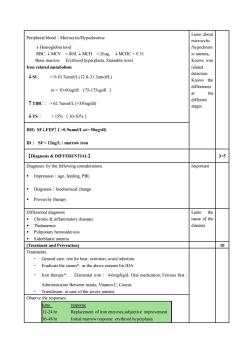
Learn aboutPeripheral bloo:Microcytic/Hypochromimicrocytic Hemoglobin level/hypochromRBC:↓MCV 62.7umol/L(>350ug/dl)stages+TS:0.9umo/Lor>50ug/dl)ID : SF<12ug/L/marrow iron3+5[Diagnosis & DIFFERENTIAL]Diagnosis:by the following considerationsImportantImpression : age, feeding, PBIDiagnosis : biochemical changeProven by therapyDifferential diagnosisLearntheChronic & inflammatory diseasesname of theThalassemiadiseasesPulmonary hemosiderosis.Siderblasticanemia10Treatment and PreventionTreatments:General care:rest for hear,nutrition, avoid infectionEradicatethe causes*: as the above reasons forIDAIron therapy*Elemental iron:4-6mg/kg/d,Oral medication,Ferrous firstAdministration Between meals; Vitamin C; CourseTransfusion:in case ofthe severe anemiaObserve the responsesresponse12-24hrReplacement of iron enzymes,subjective improvement36-48hrInitial marrowresponse:erythroidhyperplasi
Peripheral blood:Microcytic/Hypochromic Hemoglobin level RBC: MCV 62.7umol/L (>350ug/dl) TS: 0.9umol/L or> 50ug/dl) ID: SF < 12ug/L / marrow iron 【Diagnosis & DIFFERENTIAL】 3+5 Diagnosis: by the following considerations • Impression:age, feeding, PBL • Diagnosis:biochemical change • Proven by therapy Important Differential diagnosis • Chronic & inflammatory diseases • Thalassemia • Pulmonary hemosiderosis • Siderblastic anemia Learn the name of the diseases [Treatment and Prevention] 10 Treatments: • General care: rest for hear; nutrition; avoid infection. • Eradicate the causes*: as the above reasons for IDA. • Iron therapy*: Elemental iron: 4-6mg/kg/d; Oral medication; Ferrous first ; Administration Between meals; Vitamin C; Course • Transfusion: in case of the severe anemia Observe the responses: time response 12-24 hr Replacement of iron enzymes,subjective improvement 36-48 hr Initial marrow response: erythroid hyperplasia
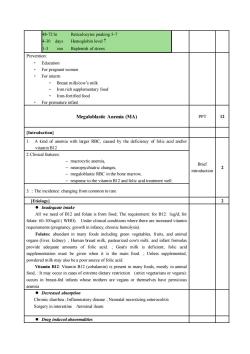
48-72hReticulocyteaking5-74-30daysHemoglobin level ↑Replenish of storesPrevention:EducationFor pregnant womenFor intermBreast milk/cow's milkIron rich supplementary foodIron-fortified foodFor premature infantMegaloblastic Anemia (MA)PPT12[Introduction]1A kind of anemia with larger RBC, caused by the deficiency of folic acid and/orvitamin B122.Clinical featuresmacrocytic anemia,Briefneuropsychiatric changesintroductionmegaloblasticRBCinthebonemarrowonse to the vitamin B12 and folic acid treatment well3. : The incidence: changing from common torare[Etiology]. Inadequate intakeAll we need of B12 and folate is from food; The requirement: for B12: lug/d, forfolate: 60-100ug/d ( WHO) Under clinical conditions where there are increased vitaminrequirements (pregnancy, growth in infancy, chronic hemolysis).Folates:abundant in many foods including green vegetables, fruits, and animalorgans (liver, kidney). ; Human breast milk, pasteurized cow's milk. and infant formulasprovidequateamountsoffolicGoat'smilkis deficient,folic acicsupples the main food.;Unless supplementedwhen:1powdered milk may also bea poor source offolic acidVitamin B12: Vitamin B12 (cobalamin) is present in many foods, mostly in animalfood, :It may occur in cases of extreme dietary restriction (strict vegetarians or vegans)occurs in breast-fed infants whose mothers are vegans or themselves have perniciousanemiaDecreasedabsorptionChronic diarrhea; Inflammatory disease ;Neonatal necrotizing enterocolitisSurgery in interestine/terminal ileumDrug induced abnormalities
48-72 hr Reticulocytes peaking 5-7 4-30 days Hemoglobin level 1-3 mo Replenish of stores Prevention: • Education • For pregnant women • For interm – Breast milk/cow’s milk – Iron rich supplementary food – Iron-fortified food • For premature infant Megaloblastic Anemia (MA) PPT 12 [Introduction] 1. A kind of anemia with larger RBC, caused by the deficiency of folic acid and/or vitamin B12 Brief introduction 2 2.Clinical features: − macrocytic anemia, − neuropsychiatric changes, − megaloblastic RBC in the bone marrow, − response to the vitamin B12 and folic acid treatment well. 3.:The incidence: changing from common to rare [Etiology] 2 ⚫ Inadequate intake All we need of B12 and folate is from food; The requirement: for B12: 1ug/d; for folate: 60-100ug/d ( WHO). Under clinical conditions where there are increased vitamin requirements (pregnancy, growth in infancy, chronic hemolysis). Folates: abundant in many foods including green vegetables, fruits, and animal organs (liver, kidney). ; Human breast milk, pasteurized cow's milk. and infant formulas provide adequate amounts of folic acid. ; Goat's milk is deficient; folic acid supplementation must be given when it is the main food. ; Unless supplemented, powdered milk may also be a poor source of folic acid. Vitamin B12: Vitamin B12 (cobalamin) is present in many foods, mostly in animal food, : It may occur in cases of extreme dietary restriction (strict vegetarians or vegans): occurs in breast-fed infants whose mothers are vegans or themselves have pernicious anemia ⚫ Decreased absorption Chronic diarrhea ; Inflammatory disease ; Neonatal necrotizing enterocolitis Surgery in interestine /terminal ileum ⚫ Drug induced abnormalities

Certain anticonvulsant drugs (e.g, phenytoin, primidone, phenobarbital) can impairabsorption of folic acidAnumber of drugs have anti-folic acid activity: MethotrexateCongenital abnormalitiesCcongenital dihydrofolatereductase deficiencyLack of intrinsic factor -Congenital permicious anemiaTranscobalamin II (TC-II) deficiency[PATHOGENESIS]1Influence on hematopoiesisMegaloblastic RBC: Decreased DNA synthesis delays the maturation of the nucleuof erythrocytes;Neutrophil and Megakaryocyte: hypersegmented neutrophils (many neutrophils withmore than four tofive lobes)Ineffectiverythropoiesis: that describenaturedeaththropoiesof cells, a decreased output of RBC from the marrow, and, consequently, anemiaInfluence on neurologic systemVitamin B12 plays important role in keeping the intact of the nerve fibers containgmyelin sheathThe deficient result in neuropsychiatric changes3[CLINICAL MANIFESTATION]General6~18moasfufuhiiglossitis.vomiting,diarrheaHair: less and yellowish.2.Anemia:Pale and puffy: icterus, Petechia: Hepatosplenomeagly3.Neurological involvementdevelopmental delay, developmental regressionTrembles, seizuresparesthesias, sensory deficits, hypotonianeuropsychiatric changes.(Neurologic problems from vitamin B12 deficiency can occur in the absence of anyhematologic abnormalities)(LAB FINDINGS)2Macrocytic normochromic anemiaFigureto
Certain anticonvulsant drugs (e.g., phenytoin, primidone, phenobarbital) can impair absorption of folic acid A number of drugs have anti–folic acid activity: Methotrexate ⚫ Congenital abnormalities Ccongenital dihydrofolate reductase deficiency; Lack of intrinsic factor - Congenital pernicious anemia Transcobalamin II (TC-II) deficiency 【PATHOGENESIS】 1 Influence on hematopoiesis Megaloblastic RBC: Decreased DNA synthesis delays the maturation of the nucleus of erythrocytes; Neutrophil and Megakaryocyte: hypersegmented neutrophils (many neutrophils with more than four to five lobes). Ineffective erythropoiesis: that describes active erythropoiesis with premature death of cells, a decreased output of RBC from the marrow, and, consequently, anemia. Influence on neurologic system Vitamin B12 plays important role in keeping the intact of the nerve fibers containg myelin sheath The deficient result in neuropsychiatric changes 【CLINICAL MANIFESTATION】 3 1. General : ⚫ 6~18mo ⚫ weakness, fatigue, failure to thrive, or irritability ⚫ glossitis, vomiting, diarrhea ⚫ Hair: less and yellowish. 2.Anemia: Pale and puffy: icterus; Petechia: Hepatosplenomeagly 3.Neurological involvement − developmental delay, developmental regression − Trembles, seizures − paresthesias, sensory deficits, hypotonia − neuropsychiatric changes. ( Neurologic problems from vitamin B12 deficiency can occur in the absence of any hematologic abnormalities) [LAB FINDINGS] 2 Macrocytic normochromic anemia Figure to
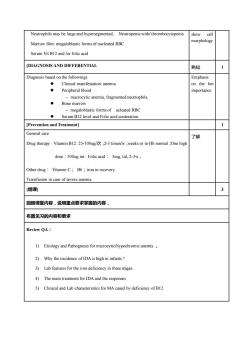
,Neutropenia with/thrombocytopeniaNeutrophils maybelargeand hypersegmentedTshowellmorphologyMarrow film: megaloblastic forms ofnucleated RBCSerum Vit B12 and /or folic acid[DIAGNOSIS AND DIFFERENTIAL熟知DiagnosisbasedonthefllowingEmphasison the bmClinical manifestation: anemiaPeripheral bloodimportanceeutrophilsnacrocvticrromegaloblasticformsof ucleated RBCSerum B12 level and Folic acid conteration[Prevention and Treatment]1General care了解Drug therapy :Vitamin B12:25-100ug/次,2-3 times/w,weeks or to Hb normal ;One highdose : 500ug im : Folic acid : 5mg,tid, 2-3wOther drug :Vitamin CB6 ; iron in recoveryTransfusion in caseemi[结课]3回顾课堂内容,说明重点要求掌握的内容,布置见习的内容和要求ReviewQA:1)EtiologyandPathognesisformicrocytic/hypochromicanemia2)Why the incidence ofIDA is high in infants3) Lab features for the iron deficiency in three stageThe main treatment forIDA and the responses5)Clinical and Lab characteristics for MA cased by deficiency ofB12
Neutrophils may be large and hypersegmented, Neutropenia with/ thrombocytopenia Marrow film: megaloblastic forms of nucleated RBC Serum Vit B12 and /or folic acid show cell morphology [DIAGNOSIS AND DIFFERENTIAL 熟知 1 Diagnosis based on the followings ⚫ Clinical manifestation: anemia ⚫ Peripheral blood − macrocytic anemia, fragmented neutrophils, ⚫ Bone marrow − megaloblastic forms of ucleated RBC ⚫ Serum B12 level and Folic acid conteration Emphasis on the bm importance [Prevention and Treatment] 1 General care Drug therapy : Vitamin B12: 25-100ug/次,2-3 times/w,weeks or to Hb normal;One high dose:500ug im : Folic acid: 5mg, tid, 2-3w, Other drug: Vitamin C; B6;iron in recovery Transfusion in case of severe anemia 了解 [结课] 3 回顾课堂内容,说明重点要求掌握的内容, 布置见习的内容和要求 Review QA: 1) Etiology and Pathognesis for microcytic/hypochromic anemia 。 2) Why the incidence of IDA is high in infants ? 3) Lab features for the iron deficiency in three stages. 4) The main treatment for IDA and the responses 5) Clinical and Lab characteristics for MA cased by deficiency of B12
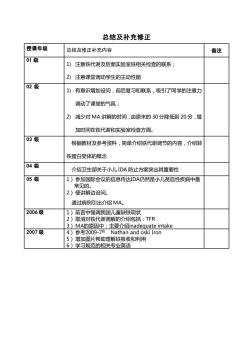
总结及补充修正授课年级总结及修正补充内容备注01级1)注意铁代谢及后面实验室铁相关检查的联系;2)注意课堂调动学生的主动性能02级1)有意识增加设问,前后复习和联系,吸引了同学的注意力调动了课堂的气氛;2)减少对MA讲解的时间,由原来的30分降低到 20分,增加时间在铁代谢和实验室检查方面。03级根据教材及参考资料,简单介绍铁代谢调节的内容,介绍转铁蛋白受体的概念04级介绍卫生部关于小儿IDA防止方案突出其重要性05级1)参加国际会议的信息传达IDA仍然是小儿贫血性疾病中最常见的。2)便讲解边设问。通过病例引出介绍 MA。2006级1)前言中强调我国儿童缺铁现状2)取消对铁代谢调解的介绍包括:TFR3)MA的原因中:主要介绍inadequate intake2007级4)参考2009-7thNathanandoskiIron5)增加图片帮助理解铁吸收和利用6)学习规范的相关专业英语
总结及补充修正 授课年级 总结及修正补充内容 备注 01 级 1) 注意铁代谢及后面实验室铁相关检查的联系; 2) 注意课堂调动学生的主动性能 02 级 1) 有意识增加设问,前后复习和联系,吸引了同学的注意力 调动了课堂的气氛; 2) 减少对 MA 讲解的时间,由原来的 30 分降低到 20 分,增 加时间在铁代谢和实验室检查方面。 03 级 根据教材及参考资料,简单介绍铁代谢调节的内容,介绍转 铁蛋白受体的概念 04 级 介绍卫生部关于小儿 IDA 防止方案突出其重要性 05 级 1) 参加国际会议的信息传达IDA仍然是小儿贫血性疾病中最 常见的。 2) 便讲解边设问。 通过病例引出介绍 MA。 2006 级 1) 前言中强调我国儿童缺铁现状 2) 取消对铁代谢调解的介绍包括:TFR 3) MA的原因中:主要介绍inadequate intake 2007 级 4) 参考2009-7 th Nathan and oski Iron 5) 增加图片帮助理解铁吸收和利用 6) 学习规范的相关专业英语
按次数下载不扣除下载券;
注册用户24小时内重复下载只扣除一次;
顺序:VIP每日次数-->可用次数-->下载券;
- 《儿科学》课程教学资源(授课教案)15 Growth Hormone Deficiency.doc
- 《儿科学》课程教学资源(授课教案)14 Congenital Hypothyroidism.doc
- 《儿科学》课程教学资源(授课教案)17 Varicella.doc
- 《儿科学》课程教学资源(授课教案)16 Measles.doc
- 《儿科学》课程教学资源(授课教案)19 Tuberculosis Meningitis.doc
- 《儿科学》课程教学资源(授课教案)20 Toxic Bacillary Dysentery.doc
- 《儿科学》课程教学资源(授课教案)21 Chronic Gastritis in Children.doc
- 《儿科学》课程教学资源(授课教案)18 Primary Pulmonary Tuberculosis.doc
- 《儿科学》课程教学资源(授课教案)24 Mumps.doc
- 《儿科学》课程教学资源(授课教案)22 Infantale Diarrhea and Fluid Therapy.doc
- 《儿科学》课程教学资源(授课教案)23 Infantile Hepatitis Syndrome.doc
- 《儿科学》课程教学资源(授课教案)25 Scarlet Fever.doc
- 《儿科学》课程教学资源(授课教案)01 Introduction of Pediatrics.doc
- 《儿科学》课程教学资源(授课教案)04 Neonatal Jaundice.doc
- 《儿科学》课程教学资源(授课教案)05 Neonatal Septicemia.doc
- 《儿科学》课程教学资源(授课教案)02 Growth and Development.doc
- 《儿科学》课程教学资源(授课教案)03 Nutrition During Childhood.doc
- 《儿科学》课程教学资源(授课教案)09 Haematopoiesis and Blood Cell Counts.doc
- 《儿科学》课程教学资源(授课教案)08 Congenital Heart Disease.doc
- 《儿科学》课程教学资源(授课教案)06 Hypoxic-ischemic Encephalopathy.doc
- 《儿科学》课程教学资源(授课教案)13 Immunodeficiency.doc
- 《儿科学》课程教学资源(授课教案)11 Acute Convulsion in Children.doc
- 《儿科学》课程教学资源(授课教案)12 Acute Glomerulonephritis,Nephrotic Syndrome.doc
- 《儿科学》课程作业习题(复习题)08 questions of immune system.doc
- 《儿科学》课程作业习题(复习题)07 questions of urinological system.doc
- 《儿科学》课程作业习题(复习题)09 questions of endocrine disorders.doc
- 《儿科学》课程作业习题(复习题)10 questions of infectious diseases.doc
- 《儿科学》课程作业习题(复习题)06 questions of nervous system.doc
- 《儿科学》课程作业习题(复习题)03 questions of respiratory diseases.doc
- 《儿科学》课程作业习题(复习题)04 questions of circulatory system.doc
- 《儿科学》课程作业习题(复习题)05 questions of blood disorders.doc
- 《儿科学》课程作业习题(复习题)02 questions of neonatal diseases.doc
- 《儿科学》课程作业习题(复习题)01 questions of children healthcare.doc
- 《儿科学》课程作业习题(典型病例)06 nephrotic syndrome-2.doc
- 《儿科学》课程作业习题(典型病例)06 anute nepheritis-1.doc
- 《儿科学》课程作业习题(典型病例)08 diarrhea.doc
- 《儿科学》课程作业习题(典型病例)03 congenital heart disease-VSD.doc
- 《儿科学》课程作业习题(典型病例)04 iron deficiency anemia.doc
- 《儿科学》课程作业习题(典型病例)05 purulent meningitis.doc
- 《儿科学》课程作业习题(典型病例)07 congenital hypothyroidism.doc
